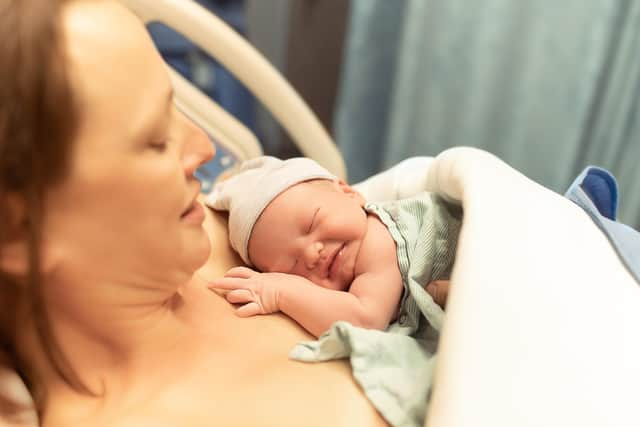Babies born to poorest Scots more than twice as likely to die, new research shows
A comprehensive independent review of health and health inequalities in Scotland, led by the Health Foundation charity, also found in the past decade inequalities have widened for infant immunisation uptake, low birth weight and childhood obesity.
The report found while infant mortality has declined overall in Scotland, since 2014 the number of children dying before their first birthday rose in the most deprived fifth of areas. By 2016/18 – with the report using a three-year average – the infant mortality rate in the most deprived areas of Scotland was 2.6 times the rate in the most affluent areas.
Advertisement
Hide AdAdvertisement
Hide AdThe National Records of Scotland (NRS) agency separately lists the infant mortality rate in Scotland as a whole and across council areas.


The rate of infant deaths across Scotland in 2019 was 3.3 per 1,000 Scots. However, the rate varies widely across council areas. For example, the infant mortality rate in Dundee City, in 2019, was nine times higher that of East Lothian.
David Finch, assistant director of the Health Foundation, has called for a “radical shift in approach” and urged the Scottish Government, councils and other organisations to step in.
“Without action, Scotland’s most deprived communities are likely to continue suffering from poor quality of life and die younger,” he said.
“A healthy community derives from a range of factors; stable jobs, good pay, quality housing and education. Poor health is almost inevitable when some or all of these factors are absent.
“Scotland’s wide and sustained health inequalities are being driven by the accumulation of severe multiple disadvantages, a lack of improvement in living standards and public service fragility due to the ongoing impact of austerity.”
Researchers also looked at the health of Scotland’s older generations. Analysis found as of 2019, there was a 24-year gap in the time spent in good health between people living in the richest and poorest 10 per cent of neighbourhoods.
The overall rate of drug deaths increased from 6.2 per 100,000 in 2001 to 25.1 in 2020. Among the poorest Scots, which the report said had driven the rise, the most deprived areas suffered from rates of 68.2 in 2020 – 18 times higher than the least deprived.
Advertisement
Hide AdAdvertisement
Hide AdAcross the country, drug deaths in 2020 were 3.6 times higher in Scotland than the UK average and 2.6 times higher than in Northern Ireland and the north east of England, which had the next highest rates.
Researchers said suicide, alcohol and drugs are the leading causes for the deaths of men aged 15 to 44.
Being younger, single, white and male is most strongly associated with experiencing severe multiple disadvantages, which are linked to greater risk of poor health, the report found.
And avoidable mortality rates among women living in the most deprived fifth of areas have increased by 8 per cent since 2010, researchers said, despite falling for the rest.
Scottish Labour’s health spokesperson Jackie Baillie described the report as “a deeply distressing revelation”.
“It is simply sickening that the life chances of Scottish children are being determined by their socio-economic status,” she said. “That the gulf in health between the poorest and richest has grown under the SNP is a damning indictment of their time in power.
“Unlike the SNP and the Tories, Labour’s priority is building a fairer, healthier Scotland for all – not more division and decline."
Scottish Conservative shadow health secretary Dr Sandesh Gulhane said: “The shocking rise in infant mortality among the poorest Scots is a badge of shame for Nicola Sturgeon.
Advertisement
Hide AdAdvertisement
Hide Ad“The widening gap in the health outcomes of Scots goes to show it’s the poorest and most vulnerable who are being disproportionately affected by years of NHS mismanagement by the SNP. This mirrors the attainment gap in education, where, again, those from disadvantaged backgrounds are being betrayed by a Government which has the nerve to claim it’s progressive.”
A Scottish Government spokesperson said: “We are determined to increase healthy life expectancy and reduce health inequalities. We know the pandemic has exacerbated existing inequalities and heightened awareness of the need to protect those at risk.
“We are deeply concerned about the cost crisis, and are doing everything we can, within our powers and fixed budgets, to support the people, communities and businesses affected most and have allocated almost £3 billion to mitigate the impact on households.
“This includes free childcare, free bus travel for under-22s, free school meals for around 145,000 pupils, Bridging Payments and the Child Winter Heating Assistance. The Scottish Child Payment increased to £25 per eligible child per week in November, an increase of 150 per cent within eight months. his benefit, only available in Scotland, also opened to eligible under-16s from that date.”
“Every drugs death is a tragedy and we are spending an additional £250 million on our national mission to tackle this public health emergency and get more people into the treatment which works for them.”
Comments
Want to join the conversation? Please or to comment on this article.